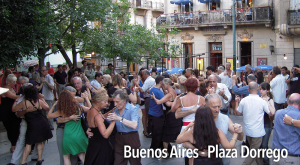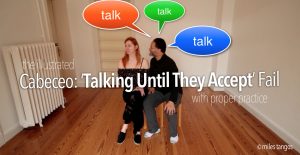Argentine Tango has a lot of wonderful vocabulary that could be called ‘Moves’. Some are very svelte, some are incredibly sexy, and some are downright amazing to the untrained eye. However, there is one move that does not require a trained eye, and doesn’t require years of training. As a matter of fact a complete beginner can master this in under 10 seconds. Sadly there are no classes or workshops on this one, except maybe this Topic.
Truth be told, the beginner dancer that does this will make themselves, and their dancing partner look absolutely fabulous regardless of how the dance went.
What is it ? It’s The ‘Classy’ Move.
This is a piece of Tango vocabulary that you absolutely want to have in your arsenal, no if’s, and’s, or but’s about it.
Let’s set this up – You invite someone to dance with you, preferably employing Cabeceo. You escort them from their table (or wherever you found them) to the floor. The dance ensues, with a bit of small-talk between the songs, and then the Tanda ends. 🙁 You say, “Thank you” and your partner responds appropriately. Up to this point everything is going well, but this is where the ‘advanced’ dancer rushes off the floor leaving their partner standing there, but you however employ – The ‘Classy’ Move!
Ready ?
This is The ‘Classy’ Move: You escort your partner back to where you found them! 🙂
Tango has certain protocols that over the years have developed into it’s own thing called ‘Codigos’. It’s the way we enter the room, ask for dances, figure out where to sit, who to talk to and why, this is the social aspect of the dance called ‘Codigos’ or the Codes of the Dance.
Sadly The ‘Classy’ Move is not taught, shown, or reinforced at all. And as a result of that lack of social knowledge you have whole generations of dancers that just rush onto and off the floor looking for their next partner, leaving their current partners standing there. In polite society, this is considered rude behavior. Codigos solves those nasty social problems that we typically create in our rush to get what we want. We can still get what we want, with elegance, and decorum, while looking fabulous doing it!
Escorting your partner from the floor – The Single Classiest Move in Tango.
And just so that we’re clear, if this sounds like the Tango Police, or claptrap, or arrogance, or as if you’re being dictated to, then you’re missing the point of the Topic. Which is ? To remind you that Tango is not about the moves, steps, patterns, or figures, or even the music, it’s about the Social aspect of the dance. Hence the reason it’s called a ‘Social Dance’. And that means treating people with respect, not rubbernecking and rushing from one dance to the next.
One More Thing: Some people will see a very typical male lead/female follower dynamic in this post. Meaning that ‘men’ are the perpetrators of this Tango ‘Crime’. 🙂 This is not case. This is not a man thing, it’s a people thing. Women do this too for a variety of reasons. So let’s not gender bash here, it’s not necessary, or warranted. This is a people thing.
A piece of this post was originally part of Tango Truisms Volume 3 – 1076. It has been updated a lot from the original post.











